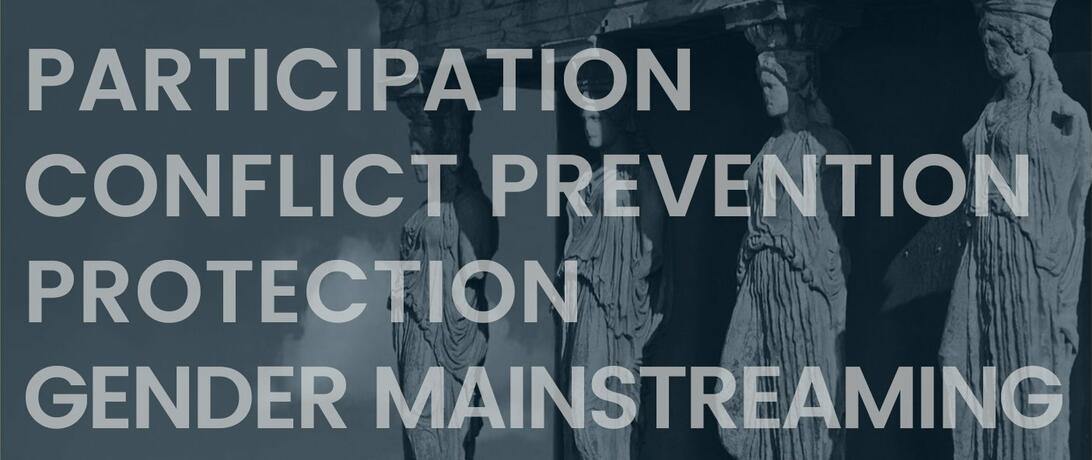
Introducing the four pillars of Women, Peace and Security: what are they and what are their goals?
In 1901, when Theodore Roosevelt said, “Speak softly, but carry a big stick,” he meant that diplomacy is important, but the real muscle of diplomacy rests in the threat of using military force. In the 21st century, when the changing nature of warfare requires a focus on preventing violent instability and mass atrocities against civilians—not just managing state-to-state relationships—strategic options based on threats are likely to fall short. For example, there are no proven military tactics for reversing a wave of violent instability or for halting genocide, and one cannot solve the threat of climate change with a bomb. Today’s security challenges go beyond managing traditional state-to-state relations. They are varied and require new ways of thinking to solve problems that do not have a clearly identifiable enemy.
In 2000, the Women, Peace and Security agenda revisited Roosevelt’s policy of Realpolitik. Using military force, or the threat of it, to meet political objectives has not always brought desired results. Witness, for example, US-initiated wars based on the concepts of compellence and deterrence in Vietnam or Iraq. The strategic options of deterrence, compellence, and containment are all policy tools based on threats.[1]
In contrast, the Women, Peace and Security agenda provides a new set of strategic options for policy makers that are not based on the threat of military force but are based on dialogue, human-rights-based approaches to security, and a new perspective on what security means—human security, not just state security. The new set of strategic options is laid out in the framework provided by UN Security Council Resolution 1325 under the four pillars of Participation, Protection, Prevention, and Gender Mainstreaming. Though the resolution does not set out specific goals in its text, its main objectives are to
- reduce violence,
- increase protection,
- stop the perpetuation of gender inequality, and
- promote gender equality.
The four pillars of Participation, Protection, Prevention, and Gender Mainstreaming provide a blueprint for nonlethal, noncoercive actions that the international community can take to address complex problems like intrastate armed conflict and humanitarian disasters.
Just like a blueprint for a house or a building, the resolution lays a foundation for UN member states and the 15 members of the Security Council to prioritize and take action with regard to gender equality and the maintenance of international peace and security. Like a blueprint, this framework contains vital information about the scope of women’s participation and gender equality in peace and security decision-making.
The four pillars, Participation, Protection, Prevention, and Gender Mainstreaming, focus on the following issues:
- Participation: The participation and inclusion of women (including civil society actors) in decision-making related to the prevention of conflict, peacemaking, and post-conflict reconstruction;
- Protection: The protection of women and girls in armed conflict, including in refugee and internal displacement situations; peacekeeping and policing; justice; constitutional, electoral, and legal processes; social and economic recovery; and the training of military and civilian personnel, including peacekeepers, on the protection of women including zero tolerance of sexual exploitation and abuse of local populations;
- Prevention: Prevention of conflict and conflict-related sexual violence, effective reporting, and protection of victims;
- Gender Mainstreaming in Peace and Security Operations: This means that member states and peace and security operations must consider the specific needs of women and men in all aspects of conflict prevention, peace negotiations, peacekeeping and peacebuilding, humanitarian response, and post-conflict governance. Gender mainstreaming specifically refers to the systematic implementation of the resolution by all member states, especially in the context of peace missions led by the United Nations.
These four pillars are essentially four tools for utilizing the Women, Peace and Security agenda in actionable steps. Policy makers can utilize the pillars to put the principles into practice, taking necessary steps to make sure women are brought to the table, that they are protected from violence, that sexual violence is effectively prevented, and that gender mainstreaming becomes an intrinsic element of peace and security operations.
Keep an eye out next week when Our Secure Future will discuss the ways that Women, Peace and Security can be put into practice and better implemented in the future.
[1] According to International Relations theory, deterrence means persuading others not to do something, and compellence means persuading others to give up something that is desired. Containment is the strategy of isolating the opposing side in order to delegitimize it, or cut it off from the rest of the global commons. The policy of containment is perhaps the most concrete and action-oriented of the strategic options available in the world of the “big stick” since it includes the options of using sanctions, travel bans, and diplomatic “freeze-out” of the representatives from the offending state.
Article Details
Published
Topic
Program
Content Type
Opinion & Insights